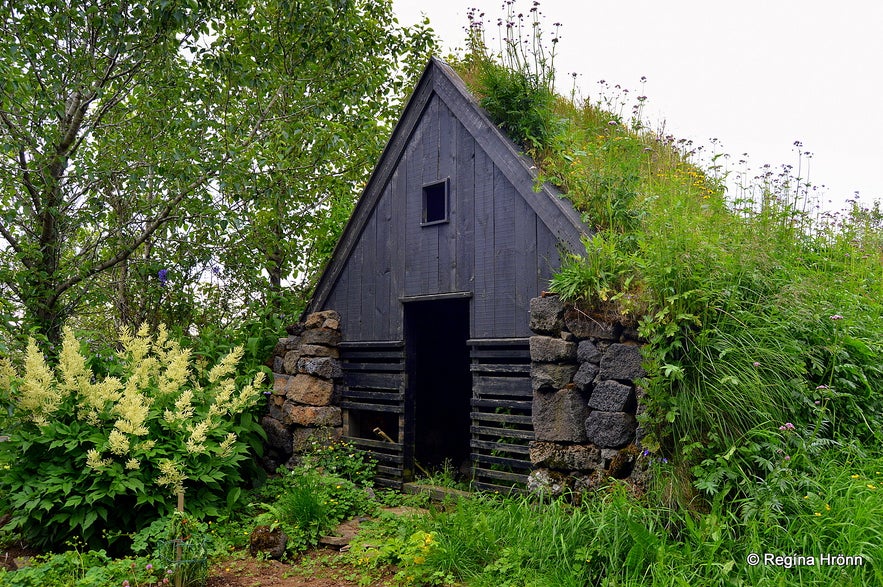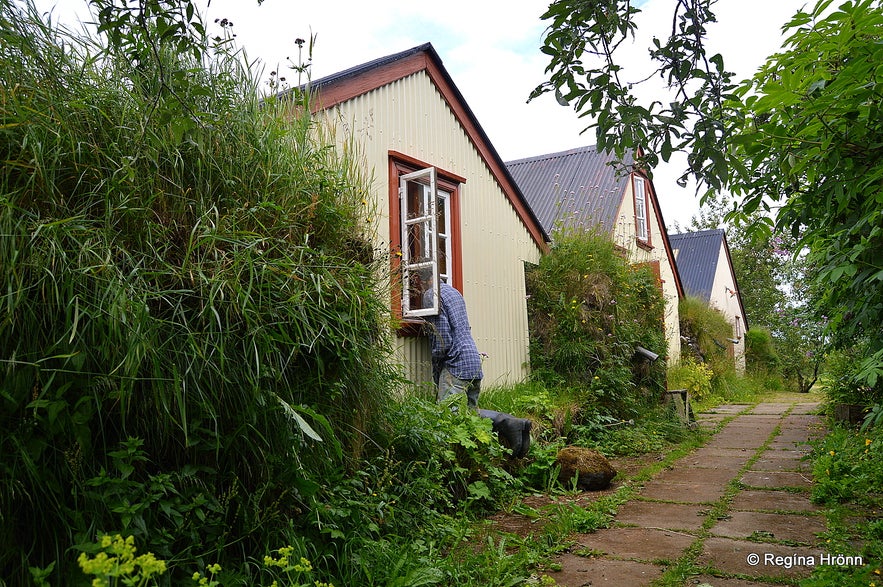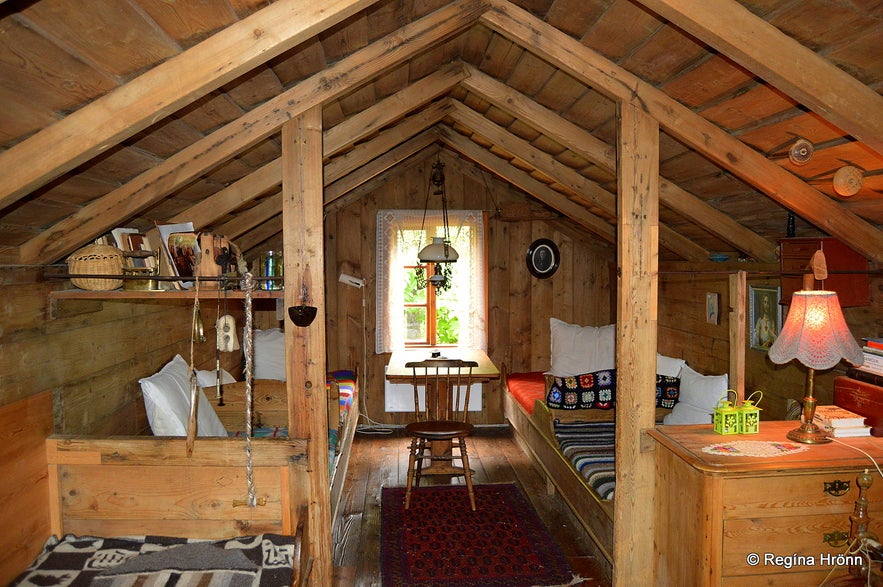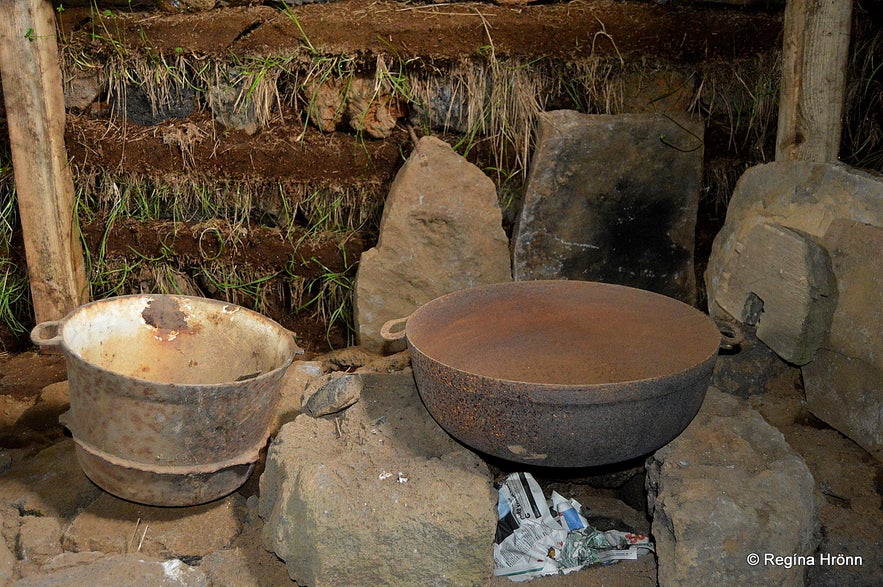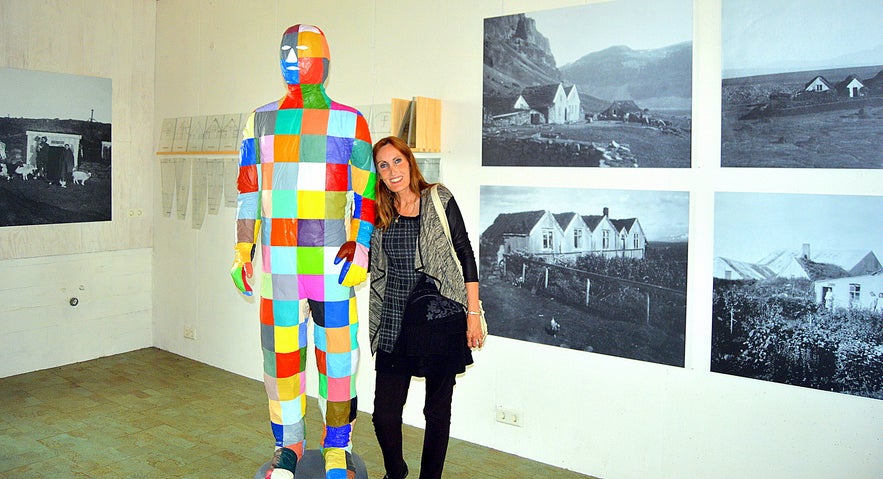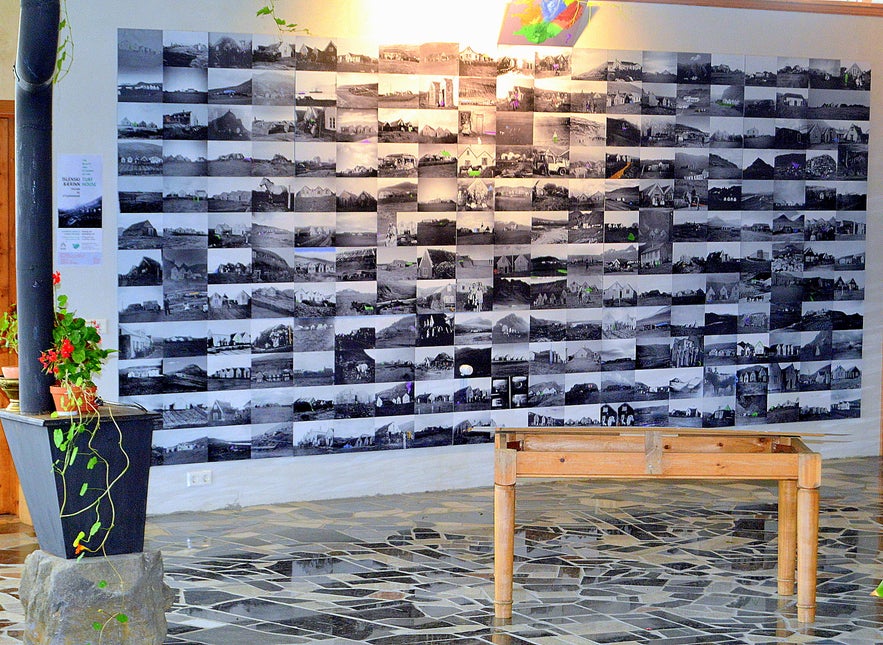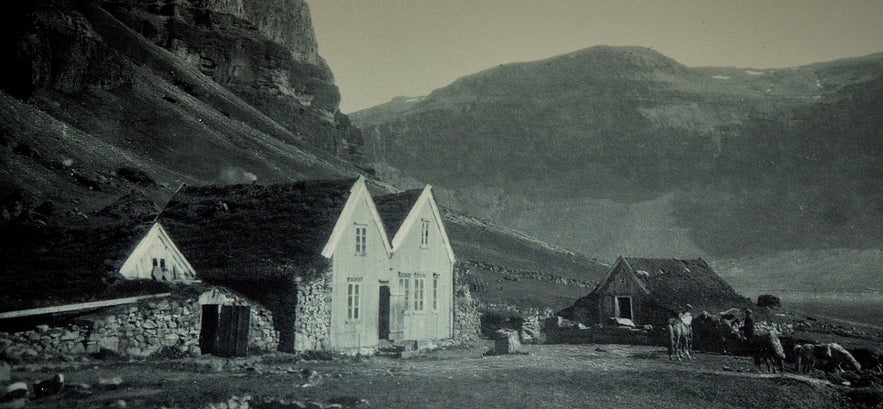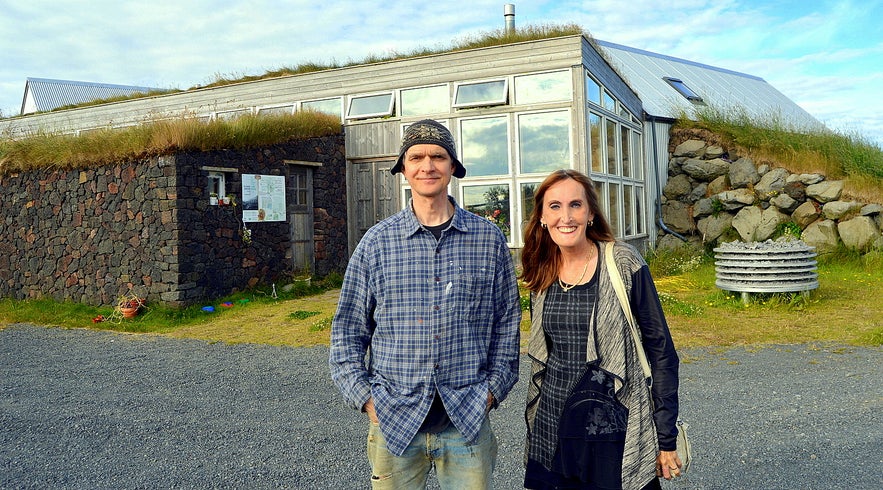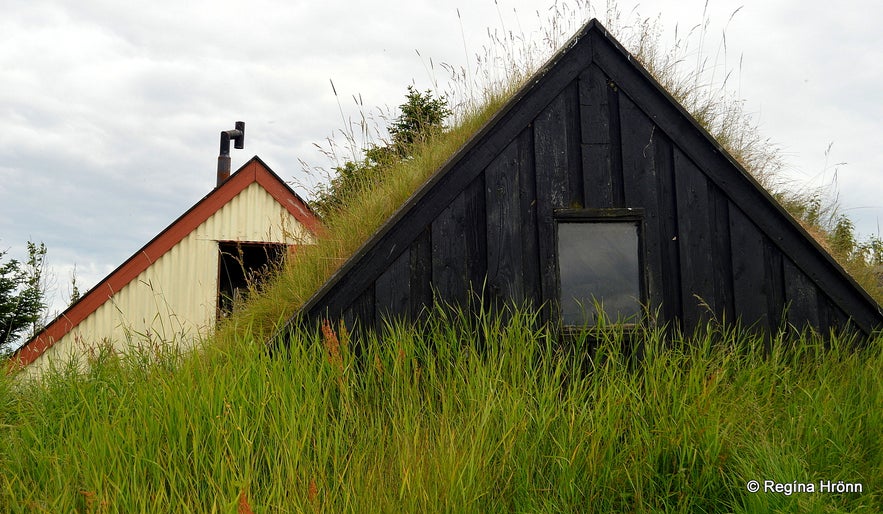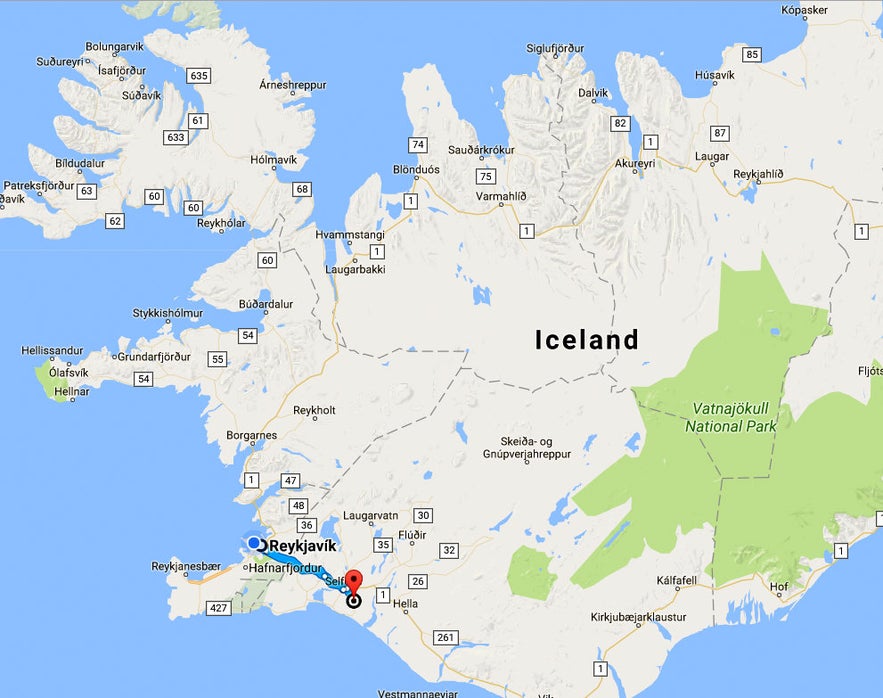
Íslenski bærinn Turf House at Austur-Meðalholt in South-Iceland
Now that I have written about almost all of the remaining turf houses in Iceland I am going to show you the turf farm at Íslenski bærinn at Austur-Meðalholt in Flói in South-Iceland. Íslenski bærinn actually means the Icelandic turf farm.
Almost all of the remaining turf houses and turf churches in Iceland belong to the Historic Building's Collection of Þjóðminjasafn Íslands - the National Museum of Iceland. But not the turf farm of Austur-Meðalholt, it is in the possession of the farmer and artist Hannes Lárusson, who maintains the turf farm himself.
Top photo: an outhouse at Íslenski bærinn
Íslenski bærinn Turf House
The turf houses at Austur-Meðalholt, which date back to the 19th century, are hidden away from sight in a beautiful grove just a short walk from the new building housing the photo exhibition.
The main turf farm consists of 4 houses, a barn and stables - all in all, 8 buildings. Hannes will walk you to the turf farm and show you inside and explain the ways of living in the olden days - or maybe not such a long ago as Hannes himself was raised on this turf farm.
Íslenski bærinn Turf House
There is also a brilliant photo exhibition at Íslenski bærinn, with old photos, drawings and models of old turf houses around Iceland.
On the west side of the turf farm, there is a potato and cabbage plot. As the trees grow so close to the farm then I could only take photos from the side and not of the front of this lovely turf farm. You can see Hannes by the window talking to other visitors while I had a look around the turf farm.
The walls of the turf farm are made with turf and rocks and the gables of the farm are made from timber. The walls and the roof are clad with corrugated iron, but that is a popular thing here in Iceland due to the wet and windy climate. You will see a lot of houses clad with corrugated iron in the old centre of Reykjavík city.
Inside Íslenski bærinn Turf House
Inside the turf farm, you will find the baðstofa or main living room, where people would eat, work and sleep. In all the turf houses the baðstofa was panelled, so on the inside, it looked like a timber house.
When the Austur-Meðalholt turf farm was rebuilt, the entire baðstofa was disassembled and all of the pieces of wood were washed separately with green soap before being put in their right place again.
There is also a hearth kitchen with old pots and pans. And a lovely furnished blue room.
The old kitchen of Íslenski bærinn Turf House
There has been a farm at Austur-Meðalholt for at least 400 years, but the current farm dates back to 1895. In 1896 there was a big earthquake in South-Iceland, but periodically there is a big earthquake in South-Iceland called Suðurlandsskjálftinn or the Southern region earthquake, the last one being in 2008. These earthquakes are caused by the movements of the North-American and Eurasian tectonic plates.
The earthquake in 1896 caused a lot of devastation and several of the turf houses in this area collapsed. Fortunately, the turf farm at Austur-Meðalholt stood upright, probably due to it being newly built.
The turf farm at Austur-Meðalholt is a typical turf farm of the "sunnlenskur" type of farm. Adjacent to the turf farm is a hovel for drying food, a barn and a storehouse.
Inside Íslenski bærinn Turf House
People lived on this farm for the next 70 years or until 1965 when it was abandoned. It stood abandoned for 20 years and was little by little mouldering.
In 1985 the farmers at Austur-Meðalholt started repairing and renovating the turf farm with the help of professionals in this field. And other people who wanted to get to know how to build a turf farm.
There are now courses and lectures on traditional turf building techniques and sustainable living held at Íslenski bærinn in co-operation with the University of Iceland and the Icelandic Art Academy. Hannes has now taught hundreds of people how to build a turf farm.
Inside Íslenski bærinn Turf House
Hannes, who is born in 1955, grew up on his family's turf farm until the age of 9. I have always thought it to be remarkable that my grandmother (born in 1923) grew up on a turf farm in the Westfjords of Iceland.
Hannes must be one of the youngest individuals with memories of living in a turf house.
Together with his mother Ásdís, who also had a passion for rebuilding and preserving the turf farm, and his wife, Kristín, Hannes has done an excellent job.
The photo collection
At the newly constructed sustainable museum building, there is also a great photo exhibition on old turf houses, which is not to be missed. Here you can learn all about this old architectural heritage.
A whole wall is covered with a photo collection of old photos of the Icelandic turf houses, most of which have disappeared.
Also, notice the floor of the museum - it is recycled from marble tabletops, which were to be thrown out - and now create this most beautiful mosaic floor.
The photo collection
I spent way too much time looking in awe at all these old photos of long-lost turf houses. It made me think of the old days when the major part of the Icelandic nation lived in turf houses, both rich and poor. And how this architectural heritage is disappearing.
I am very grateful to the visionaries who understood how important it was to preserve this architectural and national heritage.
The photo below, which is one of the photos at the exhibition, shows what Núpsstaður turf farm looked like in 1918. Notice also the cute little turf church to the right of the turf farm :)
You can see in my travel-blog about Núpsstaður what it looks like now.
Núpsstaður turf farm
Mainly the turf houses and turf churches left in Iceland have been preserved and maintained by Þjóðminjasafn Íslands - the National Museum of Iceland, but there are a few entrepreneurs like Hannes, who have maintained other turf houses or built new turf houses.
Hannes's efforts in preserving this old turf farm should be applauded as we don't want this part of our historical heritage to disappear. When Icelanders moved from the turf houses into more modern houses the turf houses were unfortunately frowned upon.
You can see Hannes in the photo below. In the background is the beautiful sustainable building housing the photo exhibition.
With Hannes at Íslenski bærinn
You can see the opening hours at Íslenski bærinn website. It is well worth the detour popping down to Íslenski torfbærinn in the area Flói in South-Iceland. It is located just 60 km away from Reykjavík city, east of Selfoss town on road 33.
To visit this area you can rent a car in Reykjavík and drive here in an hour or so. This area of Iceland is beautiful and we often drive there from Reykjavík on a day trip.
I would recommend driving further south road 33 and visit the museum village of Stokkseyri.
There you will find the Icelandic Wonders Museum, where you can experience elves and ghosts up close and personal, and the interesting Wildlife Museum, with its myriad of animals and a very knowledgeable proprietor, who happens to be my brother-in-law :)
I have written about all of the remaining turf houses in Iceland in other travel-blogs, seeing that they are very dear to me:
A list of the beautiful Icelandic turf houses I have visited on my travels in Iceland
Have a lovely time in South-Iceland :)
其他有意思的博客
冰岛最浪漫的角落
对于很多人,遥远的冰岛有着世界尽头的神秘,有着区别于巴黎、马尔代夫、自成一体的浪漫。没有埃菲尔铁塔和蒂凡尼,没有热带沙滩,而是在冰川、火山、苔藓地的背景下蜜月旅拍、婚拍,甚至举办一场冰岛婚礼。来冰岛旅行,多是要跨千山万水、飞跃大洋大陆,很有一点“万水千山陪你走过”的史诗感。难怪很多人说,光是冰岛二字,就足够浪漫了。 冰岛虽然不大,但是地貌极其丰富,不同的自然景观自然有不同的气质。这一篇,就挑阅读更多从极光观测到摄影-到底该不该来冰岛看极光
很多朋友都想来冰岛看极光,但是冰岛到底适不适合看极光呢?几月、什么季节能看到极光?是不是一定要参加北极光旅行团?如何能拍摄出美丽的极光照片呢?在冰岛住了好几年了,从刚开始逢极光必出门,到如今家里阳台就能看极光,我对在冰岛看极光的了解和经验,也算得上大半个专家了,且听我娓娓道来吧。 到底该不该来冰岛看极光呢?最坦诚的答案是,不要只为了看极光而看极光。 极光原理 太阳活动→太阅读更多
迷失冰岛的米湖游览推荐|不只有温泉的地热宝藏区
我在冬夏秋均到访过米湖,看过米湖的不同面。一直以来,米湖到底值不值得去是很多游客争论的问题。有些人觉得这里是来冰岛旅行的必去目的地,有些人则说米湖“太丑了”,连照片都不想多拍几张。那米湖到底值不值得来呢?到底怎么玩呢? 米湖的风景 北部的米湖,因地理位置相距首都雷克雅未克略远,很多来冰岛的短途游客选择放弃,其实米湖应该是和黄金圈、南岸沿线至冰湖齐名的冰岛景色,这里冷热相融,可谓最冰岛,尤其阅读更多

将冰岛最大的旅行平台下载到您的手机中,一站式管理您的整个行程
使用手机摄像头扫描此二维码,然后点击显示的链接,将冰岛最大的旅行平台添加到您的手机中。输入您的电话号码或电子邮件地址,以接收包含下载链接的短信或电子邮件。

